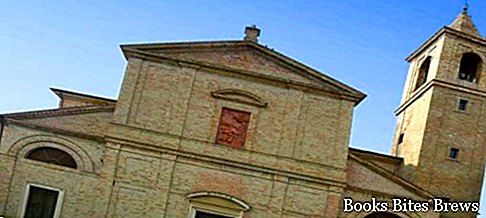What to see in Saludecio, itinerary including the main monuments and places of interest, including the Church of San Biagio, the Garibaldi Museum, the Albini Palace, the Municipal Palace and the Castle of Cerreto.
Tourist information
Located in the province of Rimini and nestled in the Valconca hills, a short distance from the border with the Marche, Saludecio is 15 km from Cattolica, 20 from Riccione and 30 from Rimini.
In the period between the fourteenth and fifteenth centuries, the village of Saludecio was long the subject of contention between the Malatesta and the Montefeltro families, later it came under the rule of the Venetians.
In 1517 Francesco Maria della Rovere took the reins of power and was succeeded by the Papal States from 1524.
Among the places to visit is the historic center, which can be accessed by passing through the ancient Porta Marina, oriented towards the sea, finding itself immediately in contact with the elegant architectural elements of the square, streets, alleys, palaces and churches .
The church of San Biagio, rebuilt between 1794 and 1800, is decorated with stuccoes by Antonio Trentanove and paintings by Guido Cagnacci, del Centino, paintings by Ridolfí and Bernardino and Vitale Guerrini.
The Garibaldi Museum contains objects and testimonies relating to the hero of the two worlds.
What see
The Municipal Palace, which was built on the ruins of the ancient fortress, is an interesting building, from an architectural point of view, for the colonnade present outside.
The Museum of Saludecio and Beato Amato is a museum dedicated to local history, with testimonies of sacred art linked above all to Sant’Amato Ronconi.
Do not miss the Palazzo Albini from 1800, with the Civic Tower from 1300, the courtyard and the sixteenth-century well.
The Civic Tower is the most significant work of the medieval period, on its façade the coat of arms of the village makes a fine show.
Recommended readings- Brisighella (Emilia Romagna): what to see
- Grazzano Visconti (Emilia Romagna): what to see
- Castelnovo ne ’Monti (Emilia Romagna): what to see
- Canossa (Emilia Romagna): what to see
- Emilia Romagna: Sunday day trips
Porta Montanara, which is the second entrance to the city, located in a diametrically opposite position to the Porta Marina, opens towards the Apennine side.
Largo Santiago de Compostela and Oratory of the hospital of Sant'Amato, are places linked to the figure of Sant'Amato Ronconi.
In the highest part of the town are the Convent with the adjacent Gerolomini Church, both dating back to the seventeenth century, and the Perfume Garden.
The Castle of Cerreto, which represents one of the best preserved rural villages in the province of Rimini, still retains evident traces of what were the fortified structures in the Middle Ages.
Located a few kilometers from the center of Saludecio, the castle is surrounded by a natural rural landscape, it is also famous for the carnival of clowns, which are very ancient artistic masks.




